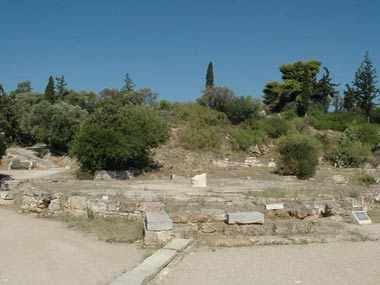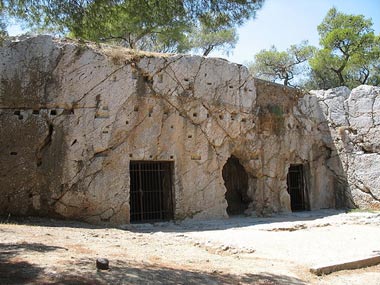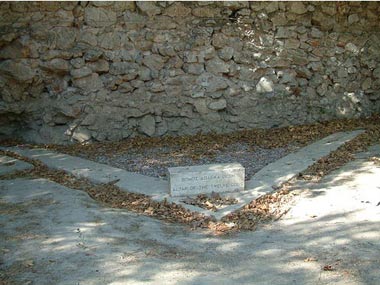Ancient Athens Administrative Center

Tholos: this was a circular building that was the social base of the democratic administration of the 50 deans who were the administrators for a tenth of the year, meaning for 36 days. Every day there was a random choice of one of them to be the caretaker of the deans just for 24 hours.
The deans enjoyed joint meals in relation to the religious rituals. Before the sessions the deans made sacrifices to god Apollo Prostatirio and Artemis Phosphoro that were co-worshipped in Tholos along with Phosphores, inferior chthonic deities, who protected the public life of the city. This was the place that the standards for the commercial transactions were kept.
The Ancient Prison of Socrates: about 100 metres from the southwestern edge of the Agora, among the ruins of houses and workshops, a public building was traced which is said to be a prison of the classical years. The building material is poor due to rapines. Among the findings there are 13 small vessels in which they were probably serving the conium, a poison meant for those who were condemned to death. A worn out small statue of Socrates was also found on the premises. All that, in combination to the testimonies from the platonic dialogues and the writings of Ploutarchos are proof that the prison of Socrates was also the ancient prison of Athens, the place where the great philosopher died.

Vouleftirio (Parliament): during the ancient times, the members of the parliament had their meetings in this outdoor location. In the beginning of the 5th century BC the old parliament is built and afterwards the new one. During the classic era 500 members were convening in the parliament and that's why we usually refer to the Parliament of the five hundred. Each one of the 10 tribes of Athens chose randomly 50 representatives for a period of one year.
Mitroo: this one is a building of the Hellenistic times. This was where they presented all the original resolutions written on papyrus, leather or wooden tables. The state would hire an employee especially for the arrangement and guard of these documents where the registry office documents were also held.
The Temple of Apollo Patroos: this is a small Ionic temple of the 4th century BC dedicated to Apollo Patroos, the father of Ionas, the primogenitor of the tribe of Iones and as a consequence of the Athenians. Apollo Patroos was one of the protector gods of Athens.
Temple of Fratrios Zeus and Fratria Athena: these adjectives, fratrios and fratria, mean brother and they were given to Athena and Zeus because they were worshipped as the protectors of the Athenian fraternities called fratries. In front of the entrance of the 4th century BC temples of Apollo Patroos, Fratrios Zeus and Athena Fratria there was an altar to which sacrifices were offered by the Athenians to the three gods.

The Archway of Zeus Eleftherios: this was a place of rest for the Athenians, decorated with incredible paintings of Ephranoras. It was built during the 5th century BC.
Vasilios Archway: it was built during the 5th century BC and today it is buried underneath the train lines. It was the base of the king who only had religious and judicial authorities. Here, there were signs with all the laws of the Athenian state from the time of Solon and afterwards.
In the northern part of the Agora were two arcways, Pikili and Ermon. Pikili archway included great paintings of Polygnotos such as the one showing the battle of Marathon. It gave its name to stoic philosophy since Zinon, its founder, used to teach here.
The altar of the twelve gods: It was built during the 6th century BC and it was used as the basis for the calculation of distances.





